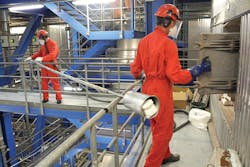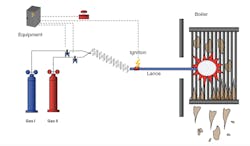Case study: Cleaning industrial facilities with controlled gas explosions
When using controlled gas explosions to clean industrial plants, cleaning is carried out while the plant is running and in compliance with strict safety regulations. This process has been used in almost every sector of industry where fuel-fired energy and power generation plants are in operation. Examples include waste-fed heating plants, biomass power stations and hazardous waste incineration plants, as well as chemical and pharmaceutical facilities. Ash and slag deposits must be removed regularly from plant components such as boilers, catalytic converters and reactors; otherwise, performance will be reduced, faults will occur and operators will be faced with high outage costs.
The Bang&Clean system for cleaning with controlled and dosed explosions was developed in 2000 for cleaning industrial plants and components. Benefits include long service lifetimes for plant components and avoided downtime. Another advantage: Plant components continue to operate during the cleaning process to avoid shutting down the plant, thus saving costs.
How it works
With Bang&Clean’s explosive cleaning system, first, the specialists introduce a water-cooled lance — prefitted with a special bag — through the boiler’s doors or portholes near the heating surface to be cleaned. The bag is inflated with a combustible gas mixture, which is then ignited to cause an explosion. This generates a highly dynamic pressure wave and causes vibrations in the pipes and walls that dislodge deposits of ash and slag.
Figure 2. Bang&Clean’s cleaning process
Throughout the process, the top priority is safety for people and machines. The cleaning equipment is CE-compliant, and it is inspected by the German Federal Institute for Materials Research and Testing (BAM). Certified experts only prepare the explosive gas mixture a few moments before the detonation in the boiler to ensure plant and personnel safety.
Application: Emergency cleaning near a nuclear power plant
Most of the company’s cleaning system deployments are planned well in advance, but there are occasional emergencies or special assignments with only a few days or hours notice. This is what happened when a U.S. plant operator contacted the company with a request to clean its components.
"That really was a very special case, because our customer’s facility was in the immediate vicinity of a nuclear power plant," said Markus Bürgin, founder and managing director of Bang&Clean Technologies AG. "To obtain approval for cleaning the plants, our customer had to submit advance proof that the cleaning method was safe."
Bang&Clean did not have the measurement expertise required to provide the necessary proof, so Bürgin called in a cooperation partner, Kistler, a company with application expertise in blast pressure measurements.
"When we received this inquiry from the U.S. at such short notice, we immediately realized that we couldn’t handle this project unless we called in the measurement technology specialists from Winterthur [Switzerland]," said Bürgin.
Given the time pressure, Bang&Clean and Kistler needed to prepare a measurement campaign within the shortest possible time. Philipp Schenkel and David Weber, Kistler’s development engineers, provided support and advice for the team headed by Bürgin throughout the project. To ensure correct measurement of the pressure values required, they opted for a relatively simple test setup in an experimental gallery at Lungern.
"For the test setup, we attached a bag to a lance, filled the bag with a gas mixture and then detonated it," said Weber.
The parameters under examination included different distances, the gas volume and the bag material. About 30 test cycles were needed to arrive at a full understanding of the ignition processes and the propagation of the pressure waves.
To measure the pressure values, Weber and Schenkel chose the Type 6233A pencil probes from Kistler. These piezoelectric sensors are ideal for measuring highly dynamic pressures in blast tests.
"In our tests, we aligned the pencil probes radially in relation to the detonation source," said Schenkel. "That allowed us to measure the pressure of the propagating blast wave directly and precisely."
As the name suggests, the sensors have a characteristic pencil shape. This feature minimizes the influence of the sensor geometry on the propagation of the blast wave and the measured signal. Rugged structural design and minimal bending sensitivity make these sensors ideal for measuring high-precision pressure signals in harsh environments. An integrated amplifier circuit (IEPE) converts the charge signal into a voltage — another advantage for applications with severe vibrations.
Figure 3. Pencil probes from Kistler measure highly dynamic pressures in blast tests.
Results
"Thanks to Kistler’s measurement results, we proved that our explosive cleaning system poses no danger either to people or the environment," said Bürgin. "So we were able to carry out the cleaning operations at our customer’s plant safely and promptly."
And there was another benefit: The measurement results helped Bürgin and his team achieve a better understanding of the product and its effectiveness. For this purpose, Bürgin is planning additional measurement campaigns and taking advantage of Kistler’s expertise for those measurements also.


